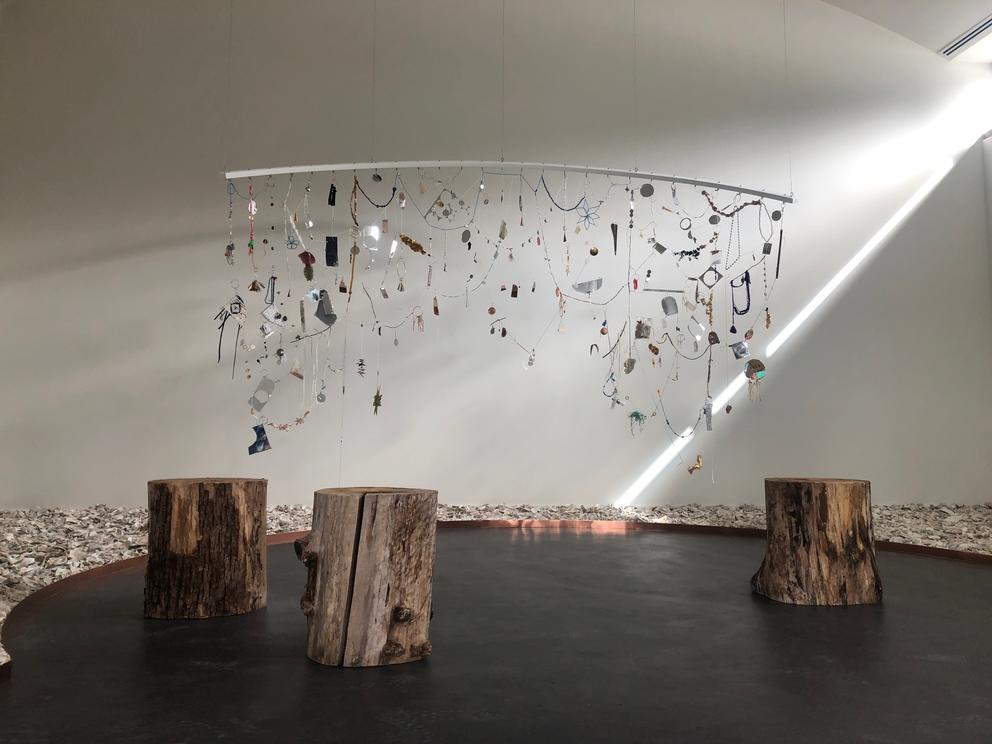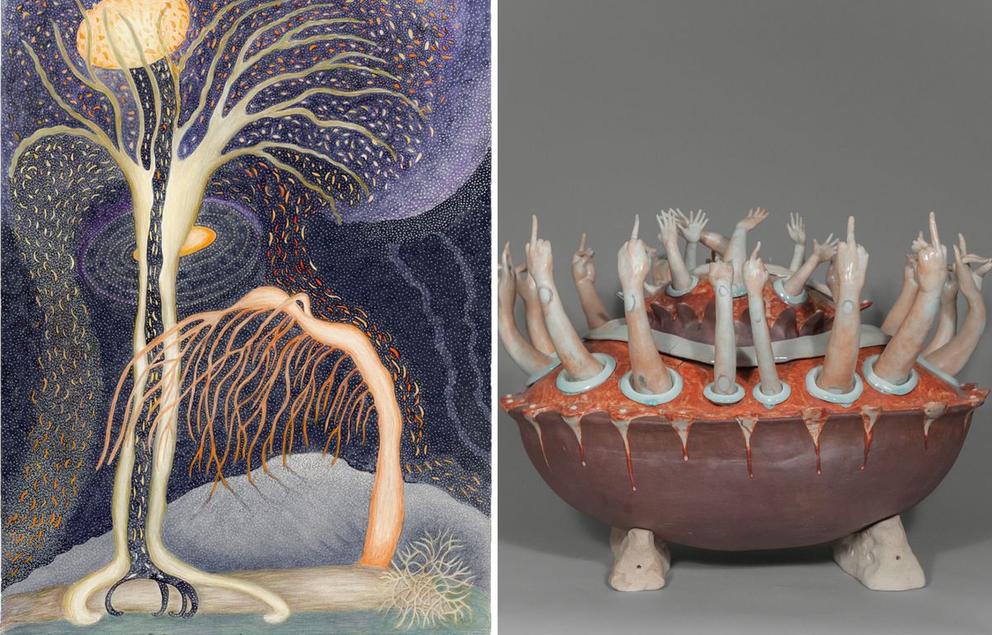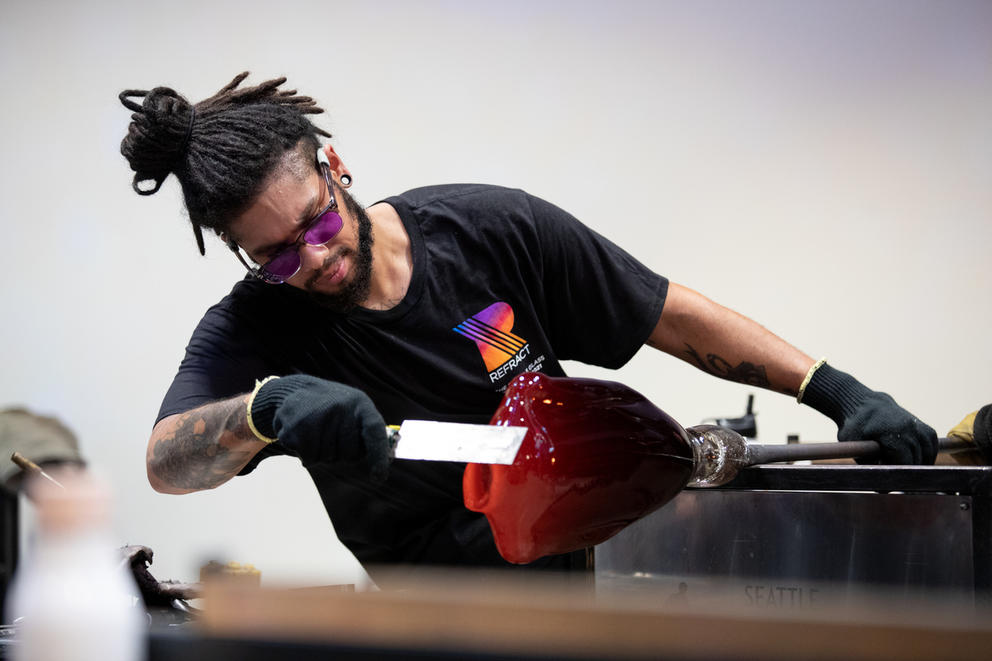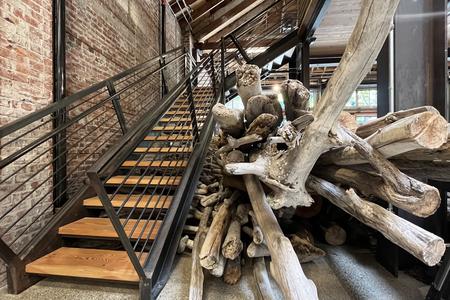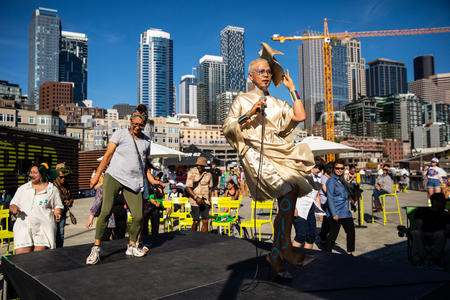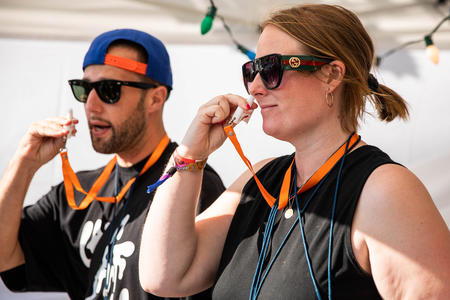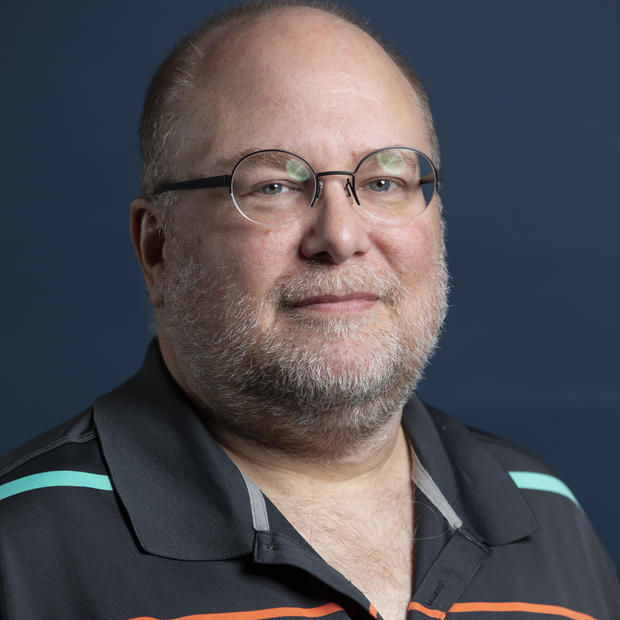A cascading archive
Near the entrance of the Henry Art Gallery currently hangs a living-memory mobile, a loose weaving made from materials collected over the years by local artists Asia Tail, Kimberly Corinne Deriana and Satpreet Kahlon of the yəhaẃ Indigenous Creatives Collective: earrings, rocks, shells, beadwork, tin jingles, copper and mica fragments, styrofoam and shiny bubblewrap packaging. Below, an oyster-shell covered floor (delineating the shape of a traditional earth lodge) and maple tree-stump seating offer a moment of grounding. In their statement, the three artists note that the installation (led by Kahlon in collaboration with Deriana and Tail) will grow with new materials during its exhibition and hope to ask: “What is the shape of mourning? what is the sound of a memory? how do we honor the sharp, tingling sensation of yearning that fills the cavity of our soft bodies when we think of how things could have been?” - MVS
If you go: this was a densely wooded hill, Henry Art Gallery, Oct. 1 - March 2023 (Pay-what-you-can)
Fall Film festivals
When All the Beauty and the Bloodshed won the Golden Lion for best film at the Venice International Film festival this September, it was only the second time in the festival’s 79-year history that a documentary took home the prestigious prize. The film, by Oscar-winning director Laura Poitras, is a portrait of artist Nan Goldin and her fight against the Sacklers, the family behind the manufacturer of the opioid OxyContin (and to many, of the opioid crisis itself). Before its wider release later this fall, the film will screen during the second edition of SIFF DocFest (Oct. 6-13). Other highlights from the documentary film festival include features on the beloved television show Reading Rainbow (Butterfly in the Sky), an all-female expedition to the North Pole (Exposure) and the Lakota people's effort to reclaim their land (Lakota Nation vs. United States).
While there are a few intriguing documentary options at the Seattle Latino Film Festival (Oct. 7-15), the main movies bookending the festival are dramas: the Bolivian dramedy Gaspar (in its U.S. premiere) and the tense psychological drama Carajita, set in the Dominican Republic.
The Seattle Queer Film Festival (Oct. 13-23) is back as well, opening with the world premiere of WHAT THE FUNK?!, a locally produced documentary about Seattle’s new all-BIPOC burlesque festival. Also on view: short movies about queer friendship, a musical comedy and a slew of intriguing national and international documentaries. The festival ends on a sweet note with the Canadian coming-of-age film Golden Delicious. - MVS
This story is part of Crosscut’s 2022 Fall Arts Preview
Feminine (higher) power
Seattle artists Ann Leda Shapiro and Hanako O’Leary work in very different media — watercolor and ceramics, respectively — but their work hums with a similar mythological-feminist sensibility. They are also friends, who are now showing their work together for the first time in a duo show called Bodies of Land. In Shapiro’s sinuous new watercolors, roots spider out into bulging bellies of soil and branches stretch into the starry sky like dendrites under a microscope. In O’Leary’s sensuous ceramics, hands, middle fingers and horns (often attached to vulvas) rise up defiantly, as part of her Izanami series influenced by imagery of the Shinto goddess of life and death. O’Leary will also debut a new installation, titled Bakoku (or “Mother’s Country”), made from hundreds of shoji-paper origami vulvas she hand-stitched into a quilt. - MVS
If you go: Bodies of Land, ArtXchange Gallery, Oct. 6 – Nov. 19 (Free)
Bubblegum immersion
Giant replicas of pink toilet paper rolls. Bubblicious gum packages as big as house beams. Coffee-table-sized dice. Curtain-length facsimiles of hair extensions. Seattle artist and curator Tariqa Waters tends to go big or go home. “I always channel either David Byrne or Pee-wee's Playhouse,” Waters told me in late 2020, ahead of her exhibition Yellow No. 5 at the Bellevue Arts Museum. There, she painted the white walls of the museum bubblegum pink (her go-to “protest color”) and put in place a supersized rotating lunchbox and thermos as an homage to her working-class single mother. While Waters remains tight-lipped about what exactly will be on view in GUM BABY, her newest immersive installation opening at the Museum of Museums this month, visitors can expect a Technicolor wonderland full of glass sculptures in Waters’ trademark mix of pop art and consumerist critique. - MVS
If you go: GUM BABY, Museum of Museums, Oct. 7 - Dec. 30 ($20)
All that jazz
It’s October, which means the return of Seattle’s longtime Earshot Jazz Festival — an opportunity to witness some of the best local and international jazz musicians, including Chicago trumpeter Marquis Hill; Moroccan master of guitar, guembri and oud Majid Bekkas; Malian singer/songwriter Habib Koité and Grammy-nominated guitarist Dan Wilson (named “the man with the magic touch”). The festival also offers an opportunity to see rising stars and local faves, like this year’s resident artist and tap-dancing saxophone maven Alex Dugdale, the Roosevelt High School Jazz Band and Seattle pianist Marina Albero. - MVS
If you go: Earshot Jazz Festival, various locations in Seattle, Oct. 8 - Nov. 6 (Prices vary)
Silver Screams
From classics to rarities, Grand Illusion Cinema has curated a Halloween-month festival of horror, starting with an extended version of the genre cornerstone Psycho (Oct. 8-12) in a 4K restoration with recently recovered bits not seen since its 1960 release. Scenes with added footage include the one in which Anthony Perkins mops up after … oops, no spoilers. And the one with the murder of … dang, this is a hard film to write about without giving things away! Later screenings include 1983’s Videodrome (Oct. 13), a film as disturbing for its anticipation of the lowest depths of reality TV as for its body horror; Nosferatu (Oct. 21-23) from 1922, the first vampire classic; and on Oct. 25, Freaks, from 1932, a “horror” film starring the denizens of a circus sideshow — the point of which, you realize as you watch, is that you shouldn’t be afraid of them. Though of course, you shouldn’t mistreat them either, because revenge isn’t pretty. - GB
If you go: All Monsters Attack!, Oct 7 - 31 ($6-$11)
Sorkin revisits Mockingbird
While the name Aaron Sorkin may conjure up scenes from the fast-paced political movie and TV dramas he famously wrote (think: The Social Network or The West Wing), Sorkin started his career as a playwright. He returned to these roots with his adaptation of Harper Lee’s classic 1960 novel To Kill a Mockingbird into a hit Broadway play now touring the country. While Sorkin doesn’t mess with the novel’s central tenets — a white small-town lawyer takes up the case of a Black man in the Jim Crow South — he does tinker with the original by making the central character, Atticus Finch, more flawed and giving more voice to the Black characters. “Broadly what we’re doing is having a new conversation about the book,” Sorkin told The Atlantic, “the story we all learned in seventh grade and thought we knew.” - MVS
If you go: To Kill a Mockingbird, The Paramount Theatre, Oct. 11 – 16 ($35-125)
Firing up the crowds
Did you know that the Northwest is kiln it when it comes to glass art? Puns aside: Our region is considered one of the world’s epicenters of “studio glass,” or glass art. The four-day glass art festival Refract hopes to remind us of this with a celebration of local glass artists and the region’s many museums and galleries that showcase their work. Now in its fourth year, Refract has become a staple of Seattle’s fall arts season, with open studios, glass-blowing lessons, live demonstrations and guided tours in Seattle and beyond (including one of the private working studio of local glass legend Dale Chihuly, as well as a behind-the-scenes tour of Sea-Tac airport’s glass art collection). It’s also a good moment to catch up on fresh artworks and newly staged exhibits, such as Native Voices, a showing of Native and Indigenous glass art at the Seattle Glassblowing Studio, and work by Chihuly (at Traver Gallery) and Ginny Ruffner (at the Bainbridge island Museum of Art). - MVS
If you go: Refract, various locations in and around Seattle, Oct. 13-16 (Prices vary)
Dance vision that’s 40/20
Having performed with top dance companies and staged the acclaimed Harlem Nutcracker, Donald Byrd was already a few impressive career chapters in when he came to Seattle to helm the then-20-year-old Spectrum Dance Theater. He’s led it ever since. “It has taken a substantial amount of time for me to do here the kind of dance that I really want to do,” Byrd told the producers of Crosscut’s Black Arts Legacies video series — which is to say: politically minded and boundary-pushing at every turn. Kicking off the “40/20” anniversary season is Occurrence #11, an engaging smorgasbord of old and new Spectrum performances for Byrd habitués and newbies alike. - MVS
If you go: Occurrence #11, Oct. 13 - 16 and 20 - 23, Madrona Bathhouse at Madrona Park. (Pay-what-you-can - $25)
Opera to die for
The first thing you hear are the cellos, playing an arching, aching phrase that lands on a bittersweet chord, skillfully orchestrated for maximum sting with plangent oboes high in the mix. The phrase repeats, a notch higher … then a third time, again higher, this time stre-e-etched … violins, overcome with emotion, emit some frankly erotic sighs … until finally the rest of the orchestra bursts in. No one had heard anything like this in 1865 when Richard Wagner’s Tristan and Isolde premiered — nor had they heard anything like the ensuing four hours, in which Wagner deployed a new strategy of never letting the music feel as if it quite settles down. It was the shrewdest musical metaphor yet devised for opera, harmonic restiveness symbolizing unfulfilled yearning, in the service of the lamest theatrical contrivance, a love potion. (Princess hates knight until they drink it, then she dies with him.) Mary Elizabeth Williams, who in past Seattle Opera performances has triumphed in everything from Mozart to Gershwin, and Stefan Vinke take the title roles. - GB
If you go: Tristan and Isolde, McCaw Hall, Oct. 16 - 29 ($62 and up)
James Baldwin on the stage
“What I wanted to do in the theatre was to recreate moments I remembered as a boy preacher, to involve the people, even against their will, to shake them up, and, hopefully, to change them.” James Baldwin wrote this about his first play, The Amen Corner. The 1954 drama, one of just two Baldwin ever wrote, has never been performed in Seattle. Under the direction of Reggie D. White, local theater ensemble The Williams Project is now staging the Harlem-set play (in collaboration with LANGSTON) and its “soaring gospel music, prophetic poetry, and gripping family drama” for local audiences. While Sister Margaret Alexander is the preacher and the main character here, The Amen Corner reflects Baldwin’s relationship with the church and his thoughts on losing (and finding) yourself in faith, love and liberation. - MVS
If you go: The Amen Corner, Langston Hughes Performing Arts Institute, Oct. 28 - Nov. 20 (Pay-what-you-can - $75)
Get the latest in local arts and culture
This weekly newsletter brings arts news and cultural events straight to your inbox.


